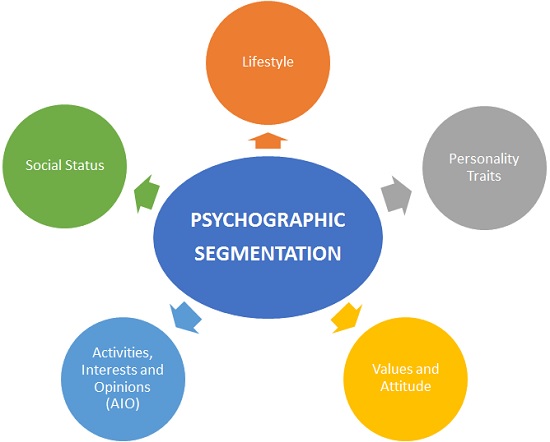Psychographic Segmentation - Definition, Importance, Parameters & Example
What is Psychographic Segmentation?
Psychographic segmentation is a segmentation method in which the total market is divided into multiple homogenous groups on the basis of parameters or variables like psychology, beliefs, values, personality, characteristics, lifestyle, attitudes, reasons etc. Psychographic segmentation helps identify people based on the way they think & the kind of life they want to live in terms of lifestyle, status etc.
This segmentation method focuses on the psychology of the customer, which can be focused upon by the company for their marketing activities. Psychographic Segmentation is rooted more in the field of psychology than conventional segmentation variables of age, income etc.
Importance of Psychographic Segmentation
Psychographic segmentation is very important in marketing and is used extensively by marketers. Companies make products in order to fulfil the needs and wants of a customer. There is a constant requirement for a customer for buying new products or services, and these wants keep on evolving and changing with age, income etc. This is directly related to the human psychology or psychographics of a customer.
Thus, if a company is able to understand the customer’s psychology, there can target them better with the products and services. In these cases, psychographic segmentation is extremely critical for a company.
Market segmentation is done by four ways, in which psychographic segmentation is one of the ways. The other ways are demographic, behavioral and geographic segmentation.
Read More
Psychographic Segmentation Parameters
Understanding the psychology is critical for a business to prosper. Hence, one of ways of reaching out to a homogenous group of customers with similar psyche can be done by considering the following variables:
1. Activities, Interests, Opinions
These three types help the company identify customers who have a similar liking towards activities, have interests in the same domain and what opinions they have about certain matters. These parameters of psychographic segmentation are also known as AIO- Activities, Interests and Opinions.
2. Lifestyle
The kind of life a person wants to live or is currently living helps in understanding their lifestyle. Lifestyle segmentation helps in understanding people with similar choices, likes, dislikes etc.
3. Personality traits
This parameter is used to group those people who exhibit similar personality characteristics. Personality traits like social, extrovert, introvert, emotional, imaginative etc are considered, which help companies approach these set of customers in a better way. This is also related to brand personality, where companies try to correlate to the customer’s personality.
4. Values and Attitudes
Along with lifestyle, values and attitude of people also help in identifying the right set of customers. This type of research is known as Values And Lifestyles (VALS) Research, and explain customers on the basis of ideals, achievements and self expression.
5. Social Status
The kind of status that a person enjoys in the society also is a relevant parameters used in this type of segmentation.
This all these parameters help in breaking down the market by psychographic segmentation

The above image shows the various parameters and variables related to psychographic segmentation
Psychographic Segmentation Example
Consider a rich businessman who wants to lead a healthy lifestyle but doesn’t find the time to and wants to reduce his excessive weight. In this case, the psychographics of the customer are that he has a posh lifestyle and can afford to spend money. Also, reducing weight and maintaining a healthy lifestyle are his top most concerns. These are the needs that a company can target using psychographic segmentation.
Psychographic Segmentation Advantages
There are several benefits of psychographic segmentation, some of which are discussed below:
1. It helps company the actual pain points of a customer by studying his/her psychology, attitudes, lifestyle etc.
2. It is extremely essential if a company wants to offer niche or customized products or services to the customer
3. Since it gives more insight about the customer, this segmentation is better than simply using demographic or geographic segmentation
4. Along with behavioral segmentation, psychographic segmentation can help completely understand the customer behavior, attitude and personality
Psychographic Segmentation Disadvantages
Despite several benefits, there are certain drawbacks of psychographic segmentation:
1. It is an extremely time consuming process, which mostly yields qualitative data, which becomes difficult to comprehend and take action upon
2. Since every customer is different, so is their psychology. Hence it becomes increasingly difficult to categorize all customers through psychographic segmentation.
Hence, this concludes the definition of Psychographic Segmentation along with its overview.
This article has been researched & authored by the Business Concepts Team. It has been reviewed & published by the MBA Skool Team. The content on MBA Skool has been created for educational & academic purpose only.
Browse the definition and meaning of more similar terms. The Management Dictionary covers over 1800 business concepts from 5 categories.
Continue Reading:
What is MBA Skool?About Us
MBA Skool is a Knowledge Resource for Management Students, Aspirants & Professionals.
Business Courses
Quizzes & Skills
Quizzes test your expertise in business and Skill tests evaluate your management traits
Related Content
All Business Sections
Write for Us